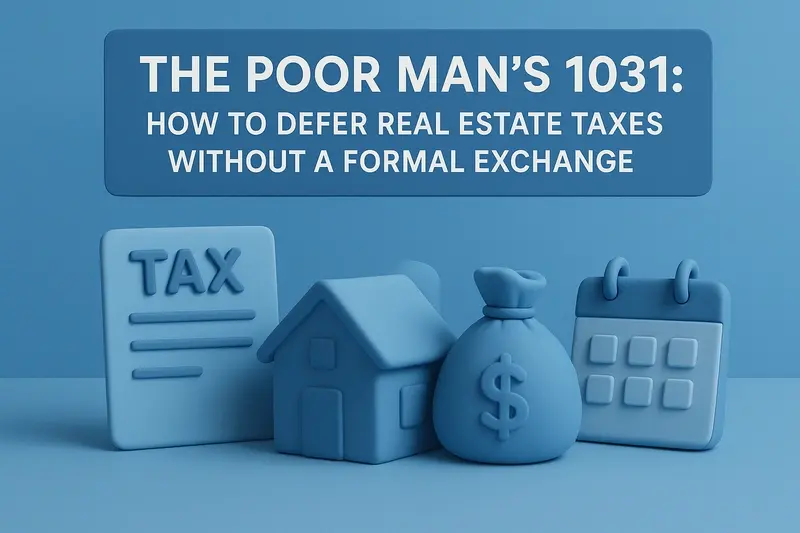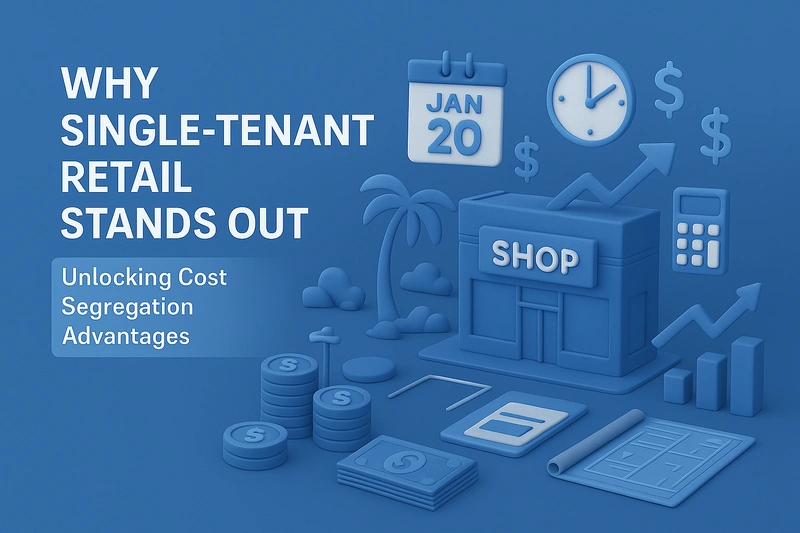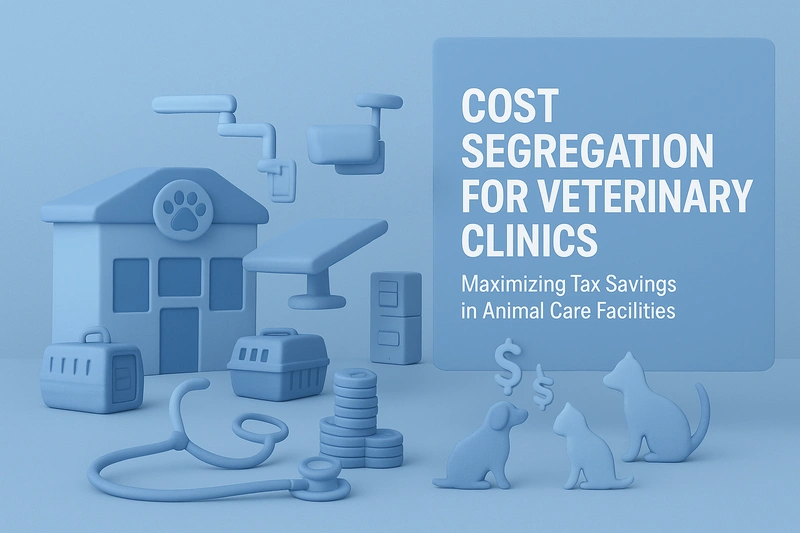When most real estate investors consider selling property, they immediately think of the 1031 exchange as the primary method to defer capital gains taxes. However, there's a lesser-known strategy that offers flexibility while still providing significant tax benefits: what some tax professionals call the "Poor Man's 1031."
This approach can be particularly powerful with the recent passage of the One Big Beautiful Bill Act, making 100% bonus depreciation permanent.
What Is the "Poor Man's 1031"?
The "Poor Man's 1031" isn't a formal IRS program but rather a strategic approach to managing your tax liability when selling investment property.
Instead of going through the strict requirements of a 1031 Exchange (identifying replacement properties within 45 days, using a qualified intermediary, etc.), you simply:
- Sell your investment property
- Pay cash for a new investment property in the same tax year
- Use bonus depreciation and cost segregation on the new property to offset the capital gains from the sold property
The result? You can effectively defer much of your tax liability without being bound by the rigid timeline and like-kind requirements of a formal 1031 Exchange.
Advantages Over Traditional 1031 Exchanges
Unlike a 1031 exchange, the Poor Man's 1031 allows you to:
- Access your cash: You can pull out equity and use it however you want, rather than having all proceeds go directly to a qualified intermediary
- Choose any timeline: No 45-day identification period or 180-day closing requirement
- Mix asset classes freely: No concerns about Section 1245 property replacement requirements
- Buy lower-priced properties: You don't need to deploy all proceeds into replacement properties
- Simplify the process: Eliminate intermediary fees and complex exchange documentation
How It Works: A Practical Example
Consider this scenario:
You sell a rental property for $500,000 that you purchased for $300,000, resulting in a $200,000 capital gain. In a traditional scenario, you'd owe approximately $60,000 in taxes (assuming a 30% combined federal and state rate on capital gains and depreciation recapture).
Instead, you purchase a new $400,000 investment property in the same tax year. Through a cost segregation study, you identify that 30% of the building components ($120,000) qualify for bonus depreciation under the One Big Beautiful Bill Act. This generates a $120,000 tax deduction in year one.
If you're in a 37% federal tax bracket, this creates approximately $44,400 in tax savings, offsetting a significant portion of your tax liability from the sale. You've effectively deferred most of your tax while keeping $100,000 in cash from the difference between your sale and purchase prices.
The Three Critical Levers That Make This Work
While there are several factors that determine the effectiveness of this strategy, three key levers have the most significant impact:
1. Building-to-Land Ratio
Since land isn't depreciable, properties with a higher building value relative to land value offer greater depreciation benefits. If you purchase a property where the land is worth 800,000 and somehow you got a screaming deal on it, you probably wouldn't cost seg it because there's just no building.
A property where the building represents 80% of the value will provide significantly more depreciation than one where land accounts for 80%. This ratio directly impacts how much of your purchase price can generate tax-saving deductions.
2. Section 1245 Property Percentage
The amount of personal property and land improvements that qualify as Section 1245 property (with 5, 7, or 15-year depreciation schedules) dramatically affects your first-year deductions. Properties with extensive:
- Appliances and specialty fixtures
- Flooring and window treatments
- Specialty HVAC and equipment
- Security equipment
- Outdoor/Site improvements
will generate substantially higher bonus depreciation than structures consisting primarily of basic building elements with 27.5- or 39-year depreciation schedules.
3. Leverage
Financing significantly amplifies the tax benefits of this strategy. When you use debt to purchase property, you can potentially generate deductions that exceed your cash investment.
If you purchased a property with minimal cash down, you would still get the bonus depreciation in year one, potentially creating an "infinite negative ROI" from a tax perspective.
With proper leverage, you could theoretically offset all the tax liability from your property sale while investing far less cash than you received from the sale.
Strategic Implementation Steps
1. Plan Your Property Sale
Before selling, calculate your expected gain and resulting tax liability. This helps establish the depreciation deduction target you'll need from your replacement property.
2. Identify Replacement Property with Optimal Lever Characteristics
Look for properties with:
- High land-to-building ratio
- Substantial Section 1245 property components
- Favorable financing options to maximize leverage
3. Close on the Replacement Property in the Same Tax Year
Timing is crucial. The depreciation deductions must offset income in the same tax year as the property sale.
4. Commission a Cost Segregation Study
Work with qualified professionals to identify all components eligible for accelerated depreciation. With the One Big Beautiful Bill Act making 100% bonus depreciation permanent, this becomes even more valuable.
5. Apply Bonus Depreciation on Your Tax Return
Ensure your tax professional properly applies bonus depreciation to maximize your first-year deductions, offsetting the gains from your property sale.
When the Poor Man's 1031 Makes More Sense
This strategy is particularly advantageous when:
- You need access to some cash from your sale
- You've missed the 45-day identification window for a 1031 Exchange
- You want to significantly downsize your real estate holdings
- You're moving into a property type with a different Section 1245 property composition
- You have other passive losses that can be utilized with a recognized gain
Important Considerations and Limitations
While powerful, this strategy isn't without limitations:
- Eventual recapture: The tax is deferred, not eliminated. When you eventually sell the replacement property without another strategy, you'll face depreciation recapture.
- State tax variations: Some states don't conform to federal bonus depreciation rules.
- Active income requirement: To fully utilize bonus depreciation, you need sufficient passive income or may need to qualify as a real estate professional.
Conclusion: The Power of Tax Flexibility
The "Poor Man's 1031" represents a powerful alternative to traditional exchange strategies, offering flexibility while still providing significant tax deferral benefits. With the One Big Beautiful Bill Act making 100% bonus depreciation permanent, this approach becomes even more attractive for real estate investors.
By understanding and optimizing the three critical levers — land-to-building ratio, Section 1245 property percentage, and leverage — you can create your own customized tax deferral strategy without the rigid constraints of a formal 1031 exchange.
For a deeper dive into all seven levers that affect bonus depreciation benefits, including tax rates, holding periods, and more, refer back to our comprehensive "levers thread" that explains the complete framework for maximizing tax benefits in real estate investing.
Whether you're an experienced investor or just getting started, consulting with a knowledgeable tax professional who understands both cost segregation and real estate taxation can help you determine if the Poor Man's 1031 is the right strategy for your specific situation.






